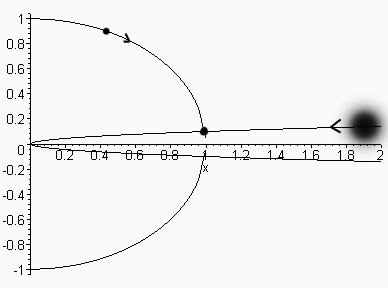![]()
- [5]a)
- Let
 Find the derivative of f, i.e.,
Find the derivative of f, i.e.,  , using any method whatsoever.
, using any method whatsoever.
- [5]b)
- Evaluate
 .
.
- [5]a)
- A function y = f(x) is defined implicitly by the relation

Find the equation of the tangent line to the graph of y = f(x) at the point
 .
.
- [5]b)
- Calculate
 at the point
at the point  .
.
- [5] a)
-
 ,
,
- [5] b)
-

- [5] a)
-
 ,
,
- [5] b)
-
 .
.
Let's assume that a planetary body is orbiting the sun (which is assumed to be very close to the origin) in a fixed almost circular orbit given by
![]()
Let's say that an asteroid is approaching the sun in an orbit whose equation is given by
![]()
see the figure below.

Use Newton's method to find the two expected points of crossing of these two orbits, i.e., the two possible collision points, to three significant digits.